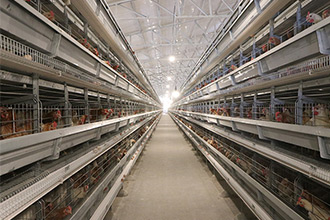In the ever-evolving world of poultry farming, efficiency and productivity are paramount. Among the various housing systems available, battery cages for layers have emerged as the most efficient choice for poultry farms. This article delves into the reasons behind their popularity, exploring the numerous benefits they offer, and providing insights on best practices for their use.

Understanding Battery Cages for Layers
Battery cages are a specialized housing system designed for layer hens, offering a controlled environment where each bird has its designated space for feeding, resting, and egg-laying. This design not only maximizes space utilization but also ensures that the birds are comfortable and safe.
Key Features of Battery Cages
-
Space Optimization: Battery cages are designed to maximize space utilization by stacking cages vertically. This allows farmers to house a higher number of layers in a compact area, making them ideal for commercial poultry farming.
-
Efficient Management: The tiered design of battery cages facilitates easy access to feed and water, ensuring a balanced diet and adequate hydration for all layers. This system also simplifies egg collection and manure management, enhancing overall farm productivity.
-
Disease Control: By isolating individual birds, battery cages help control the spread of diseases and infections. The separation prevents direct contact among birds, reducing the risk of cross-contamination.
-
Improved Egg Quality: Battery cages promote cleaner and more accessible nesting areas, resulting in better-quality eggs that are less likely to become dirty or cracked.
Advantages of Using Battery Cages
Battery cages offer a multitude of advantages that significantly enhance the productivity and profitability of poultry operations.
1. Increased Egg Production
The controlled environment of battery cages reduces stress on the hens, allowing them to focus on egg production. This leads to higher egg yields and improved egg quality. The isolation of birds also reduces social interactions and aggression, further enhancing egg production.
2. Cost-Effectiveness
Battery cages are relatively inexpensive to install and maintain. Their design simplifies management, reducing labor requirements and overall production costs. This cost-effectiveness can lead to higher profitability for poultry farmers.
3. Enhanced Bird Health and Welfare
Battery cages provide a safe and hygienic environment for laying hens. The cages are equipped with feeders and waterers that are easily accessible, reducing the risk of feed and water contamination. Additionally, individual cages prevent birds from pecking and injuring each other, improving overall flock health and welfare.
4. Better Feed Efficiency
The design of battery cages allows for precise feeding management, reducing wastage and ensuring efficient conversion of feed into eggs. This results in lower feed costs and higher profits for farmers.
5. Simplified Manure Management
Battery cages are designed with efficient manure collection systems, making it easier to remove waste. This helps maintain cleanliness in the poultry farm and reduces odors.

Best Practices for Managing Battery Cages
To maximize the benefits of battery cages, poultry farmers should adhere to best practices in their management.
-
Regular Maintenance: Inspect and maintain cages regularly to ensure they are in good condition. Repair any damages and clean the cages to prevent the build-up of dirt and waste.
-
Consistent Feed and Water Supply: Ensure a steady supply of clean water and quality feed for the hens. Monitor feeding and watering systems regularly to ensure proper functioning.
-
Appropriate Lighting: Provide appropriate lighting in the chicken house to maintain the hens’ egg-laying cycles and overall health. Use timers or automated lighting systems to regulate light exposure.
-
Proper Ventilation: Maintain good air quality and temperature within the chicken house by ensuring adequate airflow and controlling humidity levels.
-
Disease Prevention and Biosecurity: Implement strict biosecurity measures to prevent the introduction and spread of diseases. This includes limiting access to the chicken house and regularly disinfecting equipment.
Future Trends in Poultry Farming
As the poultry industry continues to evolve, several trends are expected to shape the future of egg layer cages and poultry farming.
-
Alternative Housing Systems: Growing concerns about animal welfare have led to increased interest in alternative housing systems, such as enriched cages, aviaries, and free-range systems.
-
Automation and Smart Technology: Advances in automation and smart technology are revolutionizing poultry farming, with automated feeding and watering systems, climate control, and data monitoring tools improving efficiency and production.
-
Emphasis on Health and Disease Prevention: There is a growing emphasis on proactive health management and disease prevention, with improved biosecurity measures and the use of vaccinations and probiotics to enhance bird immunity.
Conclusion
In conclusion, utilizing battery cages for layers in poultry farming offers numerous benefits, from space efficiency and enhanced productivity to improved bird health and welfare. As the demand for egg layers and poultry farming continues to grow, staying updated on future trends is crucial for success in the industry. By adopting best practices and leveraging advancements in technology, poultry farmers can optimize their operations for maximum efficiency and profitability.
For those considering battery cages, it’s essential to weigh the benefits against the welfare needs of the birds and choose a system that aligns with their farm’s objectives and requirements. Embracing these efficient housing systems can lead to a more sustainable and successful poultry farming operation.

